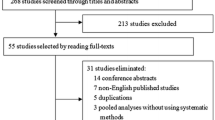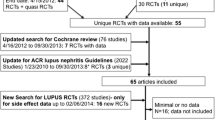Abstract
Purpose
To evaluate the efficacy and safety of the calcineurin inhibitors (CNIs) cyclosporine (CyA) and tacrolimus (TAC) in the induction and maintenance treatment of lupus nephritis (LN).
Methods
The Cochrane library, PubMed, Embase, and CENTRAL databases were searched and reviewed up to February 2015. Randomized controlled trials were analyzed using RevMan 5.2 software.
Results
Ten randomized controlled trials were selected and included in this study according to our inclusion and exclusion criteria, and six were included in the meta-analysis. The analysis results indicated that, in induction treatment, no statistically significant difference was observed in the rates of complete remission (CR), partial remission (PR), or response between the CNIs and intravenous cyclophosphamide (ivCYC). However, the rates of adverse events such as infection (RR 0.65, P = 0.04), leukocytopenia (RR 0.32, P = 0.04), and menstruation disorder (RR 0.37, P = 0.01) following the use of the CNIs were remarkably lower than those after ivCYC. No differences in the CR, PR, infection, or leukocytopenia rates were observed between the CNIs and mycophenolate mofetil (MMF). In the maintenance treatment period, the relapse rate between the CNIs and azathioprine (AZA) was similar (RR 0.44, P = 0.27), while the leukocytopenia rate was lower with the CNIs (RR 0.26, P = 0.0005).
Conclusion
The efficacy of the CNIs CyA and TAC in induction therapy for lupus nephritis is comparable to ivCYC and MMF, and they are much safer than ivCYC. CNI treatment during the maintenance period was also as effective as AZA treatment, with a much lower risk of adverse effects. The CNIs CyA and TAC should be recommended for both induction and maintenance therapy of LN.






Similar content being viewed by others
Abbreviations
- CNIs:
-
Calcineurin inhibitors
- CyA:
-
Cyclosporine
- TAC or FK506:
-
Tacrolimus
- MMF:
-
Mycophenolate
- AZA:
-
Azathioprine
- SLE:
-
Systemic lupus erythematosus
- LN:
-
Lupus nephritis
- ivCYC:
-
Intravenous cyclophosphamide
- CR:
-
Complete remission
- PR:
-
Partial remission
- NFAT:
-
Nucleus factor of activated T cell
- RCTs:
-
Randomized controlled trials
- PICO:
-
The patient/problem intervention comparison outcome principle
References
Namendys-Silva SA et al (2009) Prognostic factors in patients with systemic lupus erythematosus admitted to the intensive care unit. Lupus 18(14):1252–1258
Hogan J, Appel GB (2013) Update on the treatment of lupus nephritis. Curr Opin Nephrol Hypertens 22(2):224–230
Petri M (2004) Cyclophosphamide: new approaches for systemic lupus erythematosus. Lupus 13(5):366–371
Ferraccioli GF, Tomietto P, De Santis M (2005) Rationale for T cell inhibition by cyclosporin A in major autoimmune diseases. Ann NY Acad Sci 1051:658–665
Tanaka H et al (2012) Treatment of young patients with lupus nephritis using calcineurin inhibitors. World J Nephrol 1(6):177–183
Moroni G, Doria A, Ponticelli C (2009) Cyclosporine (CsA) in lupus nephritis: assessing the evidence. Nephrol Dial Transplant 24(1):15–20
Yap DY et al (2014) Long-term data on tacrolimus treatment in lupus nephritis. Rheumatology (Oxford) 53(12):2232–2237
Higgins JP, Green S (eds) (2011) Cochrane handbook for systematic reviews of interventions version 5.1.0 [updated March 2011]. The Cochrane Collaboration
Higgins JPT et al (2003) Measuring inconsistency in meta-analyses. BMJ 327(7414):557–560
Yin PD, Yang XY (1994) A clinical study on low dose cyclosporin A in the treatment of lupus nephritis. Zhonghua Nei Ke Za Zhi 33(10):684–686
Petrovic R et al (2002) Therapy of lupus nephritis with standard therapeutic protocols and cyclosporine. Srp Arh Celok Lek 130(Suppl 3):13–18
Wang S et al (2012) Tacrolimus versus cyclophosphamide as treatment for diffuse proliferative or membranous lupus nephritis: a non-randomized prospective cohort study. Lupus 21(9):1025–1035
Ikeuchi H et al (2014) Efficacy and safety of multi-target therapy using a combination of tacrolimus, mycophenolate mofetil and a steroid in patients with active lupus nephritis. Mod Rheumatol 24(4):618–625
Tanaka H et al (2012) Long-term tacrolimus-based immunosuppressive treatment for young patients with lupus nephritis: a prospective study in daily clinical practice. Nephron Clin Pract 121(3–4):c165–c173
Szeto CC et al (2008) Tacrolimus for the treatment of systemic lupus erythematosus with pure class V nephritis. Rheumatology (Oxf) 47(11):1678–1681
Zavada J et al (2014) Extended follow-up of the CYCLOFA-LUNE trial comparing two sequential induction and maintenance treatment regimens for proliferative lupus nephritis based either on cyclophosphamide or on cyclosporine A. Lupus 23(1):69–74
Dammacco F et al (2000) Cyclosporine-A plus steroids versus steroids alone in the 12-month treatment of systemic lupus erythematosus. Int J Clin Lab Res 30(2):67–73
El-Sehemy MS et al (2006) Comparative clinical prospective therapeutic study between cyclophosphamide, cyclosporine and azathioprine in the treatment of lupus nephritis. Egypt J Immunol 13(1):39–52
Austin HA III et al (2009) Randomized, controlled trial of prednisone, cyclophosphamide, and cyclosporine in lupus membranous nephropathy. J Am Soc Nephrol 20(4):901–911
Miyasaka N, Kawai S, Hashimoto H (2009) Efficacy and safety of tacrolimus for lupus nephritis: a placebo-controlled double-blind multicenter study. Mod Rheumatol 19(6):606–615
Zavada J et al (2010) Cyclosporine A or intravenous cyclophosphamide for lupus nephritis: the Cyclofa-Lune study. Lupus 19(11):1281–1289
Griffiths B et al (2010) The BILAG multi-centre open randomized controlled trial comparing ciclosporin vs azathioprine in patients with severe SLE. Rheumatology (Oxf) 49(4):723–732
Chen W et al (2011) Short-term outcomes of induction therapy with tacrolimus versus cyclophosphamide for active lupus nephritis: a multicenter randomized clinical trial. Am J Kidney Dis 57(2):235–244
Yap DY et al (2012) Pilot 24 month study to compare mycophenolate mofetil and tacrolimus in the treatment of membranous lupus nephritis with nephrotic syndrome. Nephrology (Carlton) 17(4):352–357
Li X et al (2012) Mycophenolate mofetil or tacrolimus compared with intravenous cyclophosphamide in the induction treatment for active lupus nephritis. Nephrol Dial Transplant 27(4):1467–1472
Moroni G et al (2006) A randomized pilot trial comparing cyclosporine and azathioprine for maintenance therapy in diffuse lupus nephritis over four years. Clin J Am Soc Nephrol 1(5):925–932
Chen W et al (2012) Outcomes of maintenance therapy with tacrolimus versus azathioprine for active lupus nephritis: a multicenter randomized clinical trial. Lupus 21(9):944–952
Anders H-J, Appel GB (2012) Lupus nephritis: implications of the new ACR lupus nephritis guidelines. Nat Rev Nephrol 8(9):500–501
Hahn BH et al (2012) American College of Rheumatology guidelines for screening, treatment, and management of lupus nephritis. Arthritis Care Res 64(6):797–808
Podracka L, Matousovic K (2013) Practice guideline and trends for immunosuppressive treatment of glomerulonephritides according to KDIGO (Clinical Practice Guideline for Glomerulonephritis). Vnitr Lek 59(2):113–118
Waldman M, Appel GB (2006) Update on the treatment of lupus nephritis. Kidney Int 70(8):1403–1412
Tian SY et al (2014) Immunosuppressive therapies for the induction treatment of proliferative lupus nephritis: a systematic review and network metaanalysis. J Rheumatol 41(10):1998–2007
Webster P et al (2014) Tacrolimus is an effective treatment for lupus nephritis in pregnancy. Lupus 23(11):1192–1196
Lee YH et al (2011) Efficacy and safety of tacrolimus therapy for lupus nephritis: a systematic review of clinical trials. Lupus 20(6):636–640
Deng J et al (2012) A meta-analysis of randomized controlled trials comparing tacrolimus with intravenous cyclophosphamide in the induction treatment for lupus nephritis. Tohoku J Exp Med 227(4):281–288
Zhou DJ, Wu XC (2011) Meta-analysis of calcineurin inhibitor in the treatment of lupus nephritis. Zhonghua Er Ke Za Zhi 49(4):287–293
Yang M et al (2014) Calcineurin inhibitors may be a reasonable alternative to cyclophosphamide in the induction treatment of active lupus nephritis: a systematic review and meta-analysis. Exp Ther Med 7(6):1663–1670
Masson P et al (2013) Induction and maintenance treatment of proliferative lupus nephritis: a meta-analysis of randomized controlled trials. Am J Kidney Dis 61(1):74–87
Authors contribution
Wei Qin. planned the study, analyzed data, and assisted in article preparation. Xiaoyan Zhang and Ling Ji searched the literature, selected articles, extracted data, analyzed data, and composed of the article. Lichuan Yang and Xiaohong Tang assisted in the data analysis. All authors read and approved the final manuscript.
Author information
Authors and Affiliations
Corresponding author
Ethics declarations
Conflict of interest
None of the authors have any competing interests.
Additional information
Xiaoyan Zhang and Ling Ji have contributed equally to this article.
Rights and permissions
About this article
Cite this article
Zhang, X., Ji, L., Yang, L. et al. The effect of calcineurin inhibitors in the induction and maintenance treatment of lupus nephritis: a systematic review and meta-analysis. Int Urol Nephrol 48, 731–743 (2016). https://doi.org/10.1007/s11255-015-1201-z
Received:
Accepted:
Published:
Issue Date:
DOI: https://doi.org/10.1007/s11255-015-1201-z




